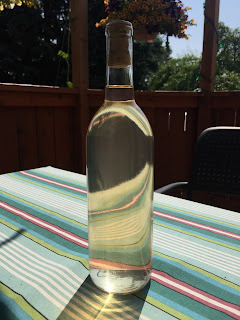Way back in October 2016, I was frustrated with
stuck fermentation on a batch of mead. Adding yeast nutrient/energizer, fermentation seemed to do the trick. Three months later, in January, I measured the specific gravity (0.996) and decided to rack it. Some residual haziness remained, so I let this mead sit for 7 months in the dark, in a sealed carboy, hoping that this little bit of cloudiness would settle out. Last week, I decided to rack again, and maybe bottle it.
During the racking, I took pains to avoid bumping the walls of the carboy with the auto-siphon, as fine particles had settled there. I also left avoided siphoning off the bottom inch (or so) of liquid, thus avoiding most of the fine sediment. The racked mead seemed to not have any visible particulates, although there was still a fine haze. I decided that it probably wasn't going to get much better by letting it sit for another half a year, so I went ahead and bottled. And, frankly, the minor haziness is something I can live with.
 |
| Minor haziness is most visible in full sunlight. |
The final specific gravity was 0.994, slightly lower (but within experimental error) than the s.g. in January. Total yield was 14 bottles, plus another 300 mL or so that I put in the fridge for immediate consumption.
So, is it any good? Well, yes. This mead is far better than the my first attempt, which was made using some generic honey from Costco. This one has more interesting, complex honey flavours, and it tastes 'clean'. It is also very dry and it's delicious when chilled - a perfect summer treat.



